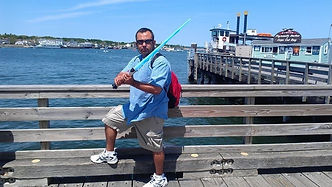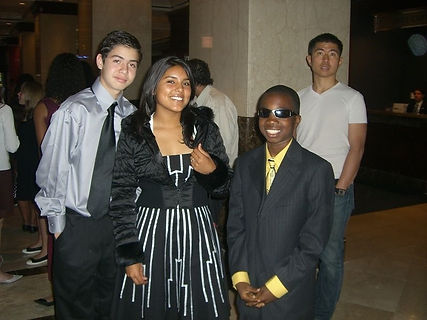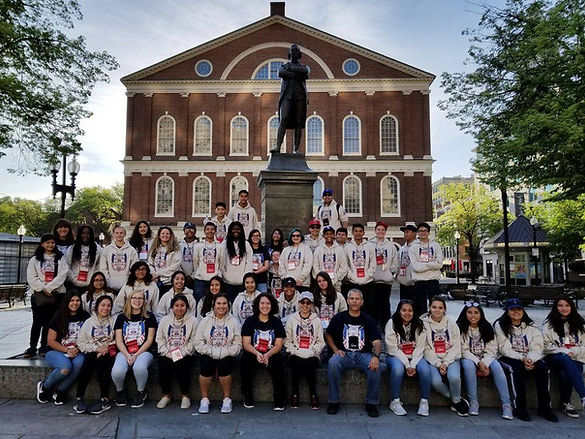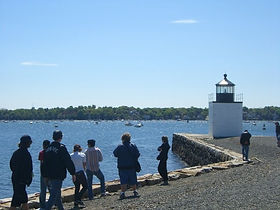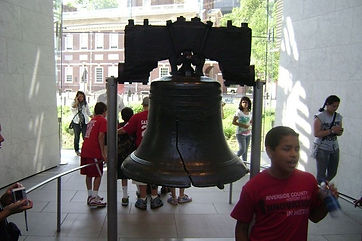
Cortez History
The Official Website of Mr. Cortez
Vista Heights Middle School



Sign up for the East Coast Trip Today!


Interested?
Attend an informational meeting:
Current 8th, 7th, and 6th Graders: I will be holding an informational meeting in the MPR at Vista Heights on Thursday, August 21st. Any parents interested in sending their child on the East Coast Tour in May of their 8th grade year should attend! The meeting will be from 6:00-7:15pm.
It is an informational meeting only; many topics will be covered, including:
date and cost of the trip/payment information/how to sign up/who are the chaperones/safety issues/hotel information/cities and sites we'll visit/questions and answers/and more!
Please download the following flyer:
About the trip:
- The cost of the Trip is approx $3699.00 for the 2026 Trip.
- The Trip is in late May of your 8th grade year. You will miss five days of school. This is AFTER State testing, so don't worry about that. We will depart on a Sunday afternoon and return on a late Sunday night. (Note: The 2027 Trip will take place in June, after the school year has ended.)
- Sign up as soon as you can, because the top 45 are guaranteed a spot on the Trip. If you register after the top 45 spots have been filled, you will be placed on a Waiting List.
- We will visit four major cities, and various other towns.
- Minimum 2.0 GPA required and no F grades. Student behavioral record will be assessed by Mr. Cortez and Ms. Williams.
- Get your friends to sign up and perhaps they'll be your roommates in the hotels!
SIGN UP FOR THE TEXT MESSAGE NOTIFICATIONS TODAY!
TO REGISTER:
incoming 8th graders: Text @ECT2026 to 81010
incoming 7th graders: Text @ECT2027 to 81010
incoming 6th graders: Text @ECT2028 to 81010
(If your cell phone doesn't allow you to send messages to short numbers like 81010, then you need to either download the Remind app or download a different messaging app.)
I strongly recommend this experience for all students. It is strategically organized, safe, and a great time for students to bond. But most importantly, it is LIFE-CHANGING. Your child will have the opportunity to come face-to-face with many of the historic sites and topics that are studied throughout the course of middle and high school.
HERE'S HOW TO SIGN UP:
To register now, visit www.applestudenttours.org, click on "Register", then enter the following Tour Code:
2026 Trip - ZAD972 (this code works for incoming 8th graders)
2027 Trip - M23F6E (this code works for incoming 7th graders)
2028 Trip - 68EL52 (this code works for incoming 6th graders)
After filling out the required information, submit a $250 non-refundable deposit. Call Apple Student Tours for further payment details at (619) 299-9686. (If you register online and haven't attended an information meeting before, I recommend you attend the meeting mentioned above.)
Any questions? Please email Mr. Cortez at acortez@mvusd.net.
-------------------------------------------------------------------------------------
Peyton Makes it to Nationals!




Peyton, a student from my 6th grade class, beat out the entire state of California and made it the National History Day contest at the University of Maryland! She's obviously a determined and brilliant kid, and her History Day topic was really interesting - the Bradford Sweets Poisoning of 1858. (look it up!)
We had a blast at the National contest, touring Washington, D.C., Baltimore, etc. She's already working hard to make it back next year!
Norco Speech Meet Results!






On Saturday, March 23rd, a number of my students participated in the Friends of Forensics Speech Meet, held at John F Kennedy Middle College High School in Norco. There were about 150 total registered participants.
There were four categories: Informative, Storytelling, Current Events, and My Hero. Each category had dozens of participants from many schools in CNUSD, MVUSD, etc. … and each category had a first, second, and third place winner.
For the first time ever, Vista Heights took place the FIRST PLACE TROPHY, beating out all the schools! We also had one first place winners (Ava Rodriguez), two second place winners (Jordyn Spencer and Ethan Smith), and one third place winner (Amanda O'Dell)!
What Happened at Roanoke Island?

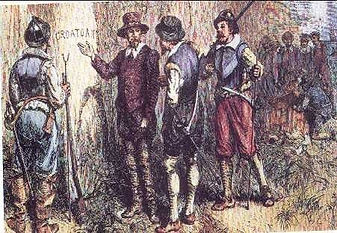
Roanoke Island is famous for having the first ever English colonial settlement in the New World. But what it is most famous for is how mysteriously these first English settlers disappeared after a short time. Some say that they were killed; others say that they hid; still others say that they were absorbed into the native tribes. These settlers in Roanoke Island, who mysteriously disappeared without a trace, are popularly referred to as "The Lost Colony."
While Jamestown was the first permanent settlement in the New World, Roanoke Island was host to English settlers even before the start of the 16th century. Roanoke Island is where the first child of English decent was born in the New World, and there had been many speculations as to what happened to the colony after that. King James I of England even made it a point to go on the first voyage to Jamestown to search for the first colony in America.
The Return
It was in 1584 when the first group of English settlers made settlements in Roanoke Island. This first batch of settlers consisted of a hundred men, but the quickly abandoned their first settlement due to harsh weather conditions and their failure to keep a good relationship with the native tribes. After three years, the second batch of English settlers set foot on the island in July. After a month, the first English child was born in the New World. A week after Eleanor Dare's child was born, his grandfather, Captain John White, set sail for England to bring them back food supplies and materials. What Captain White expected to be a short trip turned out to be a long stay in his motherland. The Spaniards attacked England, and there were many other unexpected events, and so he managed to return to Roanoke Island three years later.
A Mystery
What Captain John White saw was mysterious and utterly unbelievable. His daughter, Eleanor Dare, and his granddaughter, Virginia Dare, were nowhere to be seen! He saw no one from the English settlement he left three years earlier, and the place was bare of any signs of life as even the houses were nowhere to be seen. The letters "CRO" was sketched on a nearby tree and the word "Croatan" was found on a post, but even a visit to the Croatoan Indians gave him no answer as to where his family and the English colony had gone.
Some say that the colony was wiped out by a violent deadly storm, and it was easy to imagine that on an island. Others say that the settlers had been the subject of brutal attacks by nearby native tribes, to help prevent future colonization on the island. Others say that they had intermingled with and become absorbed into the native population, that they became so comfortable with living as natives that they ultimately decided not to return to the colony. The loss of more than a hundred people, consisting of 90 men, 17 women and 9 children, marks the mysterious end of the first ever attempt to establish a permanent settlement in the New World.
(The above taken from http://totallyhistory.com/roanoke-island-mystery/)
Excellent Video on the Lost Colony of Roanoke
Audio: What Happened to the Lost Colony?
"Starving Time" at Jamestown
The first English settlement in the New World was at Jamestown in the colony of Virginia. In time, Virginia became a success, but early on, it was an utter failure. The weather and disease played a major part in the struggle to survive.
The harsh winter of 1609 in Virginia?s Jamestown Colony forced residents to do the unthinkable. A recent excavation at the historic site discovered the carcasses of dogs, cats and horses consumed during the season commonly called the Starving Time. But a few other newly discovered bones in particular, though, tell a far more gruesome story: the dismemberment and cannibalization of a 14-year-old English girl. (from SmithsonianMag.com)
Read more about archaeology at Jamestown here.
Text Message Notifications

One of the most helpful things I do for students and parents is offer a text message notifications system (which allows everyone to keep their privacy). By signing up, you'll be given updates for upcoming tests, homework, projects, and more.
In order to register, you'll need to text the proper code to the number 81010:
8th grade History Classes, Periods 1, 5, & 7: Text @MrCortez to 81010
8th grade Junior Scholars GATE Classes, Periods 4 & 6: Text @GateClass to 81010
2025 East Coast Trip (for current 8th graders): Text @ECT2025 to 81010
2026 East Coast Trip (for current 7th graders): Text @ECT2026 to 81010
2027 East Coast Trip (for current 6th graders): Text @ECT2027 to 81010
Speech Meet: Text @oratorical to 81010
Visit www.remind.com for more info, and make sure to download the Remind app for Android or Apple.
The House of Burgesses Explained
Captain John Smith and Pocahontas
Click on the portraits above to learn more about Captain John Smith and Pocahontas.
The Embarkation of the Pilgrims
The painting below is called "Embarkation of the Pilgrims"; it hangs in the Capitol Building in Washington, D.C. It shows the Pilgrims as they pray moments before departing Holland to go to England, where they would gather with others to go to the New World.
Explore the painting and learn a thing or two about the Pilgrims.
Click on the key below:

About Mayflower and its Passengers


Traveling on the ocean 400 years ago was a very different experience than it is today. Mayflower didn't have private cabins with windows and beds for each person. There were no computers, televisions, air conditioners, fancy meals or swimming pools.
In the 1600s, most ships were merchant ships. They were made for carrying cargo, like barrels of food or cloth, large pieces of wood, and casks of wine, from one place to another to be sold. Before Mayflower sailed to New England, it had been sailing around Europe carrying wine and cloth. This cargo was probably stored in the lower decks of the ship in one large, open storage area. There were no windows on this deck because windows might let in seawater that would ruin the cargo. A little water would leak in anyway, though, so this area was always cold, damp and dark.
The storage decks had very low ceilings. They didn't need to make the decks very high because barrels and boxes weren't very tall. The ship had low-ceilinged decks to make it safer and to save space for the decks where the sailors lived. A ship that was too tall might tip over or sink.
The crew (sailors and officers of the ship) lived on the upper decks. In 1620, there were about 20-30 crewmembers on Mayflower. The Master, in charge of sailing the ship, was Christopher Jones. We would call him a "captain" today. He probably had his quarters, or living space, at the stern (the back) of the ship. This was the driest and most comfortable area on the ship.
The common sailors, or regular workers, had their quarters at the front of the ship, or bow, in a room called the forecastle. The forecastle was not a pleasant place to sleep or eat. It was in a part of the ship constantly hit by waves, so it was always wet and cold. The sailors would have to get used to the swaying and pitching of the ship because it was at its strongest here. Also, most of the men would be going to the bathroom at the head, which was at the very tip of the bow, so the forecastle wasn't very clean.
There were also officers on Mayflower. They were responsible for sailing and navigating the ship. They probably lived in the space between the Master and the common sailors. Their quarters weren't as spacious or comfortable as the Master 's, but they weren't as awful as the space for the common sailors.
Where did the passengers live on Mayflower? The ship carried 102 men, women and children passengers on its only trip to New England. The passengers were the cargo, so they all had to live in the dark, cold cargo decks below the crew's quarters.
(taken from Plimoth.org, the official site of Plimoth Plantation)
Oratorical Contest Update
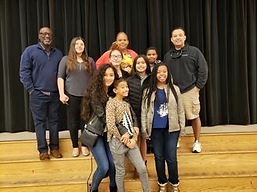
On Saturday, February 4th, eight Vista Heights students participated in the 30th annual Alpha Phi Alpha/Alpha Kappa Alpha Oratorical Contest. It was held at Heritage Middle School in Fontana.
There was some serious competition this year, yet Peyton English from Vista Heights beat out 33 others to win 1st place! By beating out kids from all over the Inland Empire, she won a trophy and $200!
Could You be Related to a Pilgrim?
What's the Big Deal with the Mayflower Compact
So what's the big deal with the Mayflower Compact? The Mayflower Compact is the planted seed that grows up to become the United States and it's America's first constitution. Read about it here.

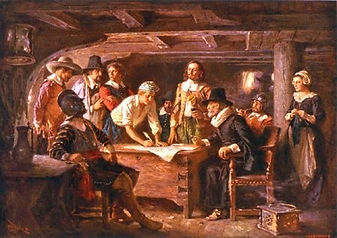


The First Thanksgiving
Click play to listen to a few hours of wonderful teaching about the Pilgrims - their voyage, their struggles, and the meaning of the First Thanksgiving. Highly recommended!
Who Ate Roger Williams?


Theologian Roger Williams was renowned as an advocate of religious freedom and separation of church and state, issues not popular in his day. This story, however, is about what happened to his interred body.
Roger Williams Eaten by Tree
The body of 17th century religious emancipator Roger Williams was eaten by a tree. First, the events that led to this unique discovery.
Williams was buried in a poorly marked grave in the back yard of his home. You see, because of the principles that Williams fought for, public burials were, for a time, outlawed in Rhode Island.
In 1860 Stephen Randall, a Roger Williams descendant, ordered workmen to exhume the remains from the Providence, RI plot and transfer them to a more suitable tomb. The excavation, however, yielded only a few badly rusted coffin nails and some scraps of rotten wood. No bones were found.
No Bones, but a Body Shaped Root
The workmen, however, did find something extraordinary. The ramifying root of a nearby apple tree lay exactly where the remains should have been and it had taken the shape of Williams? body, from head to heels.
As it grew, the root apparently had encountered Williams? skull and followed the path of least resistance, inching down the side of his head, backbone, hips and legs, molding itself closely to the contours of his body.
The corpse itself was gone?absorbed into the tree through the roots. The tree had enveloped, then absorbed Roger Williams.
Bones, supposedly - even of human bones - are an excellent fertilizer for fruit trees; and the fact must be admitted that the organic matter of Roger Williams? had bloomed in the apple blossoms, and had become pleasant to the eye; and more, it had gone into the fruit from year to year, so that the question might be asked, Who ate Roger Williams??
Root Given to Historical Society
The human-shaped root, silent testimony to an unusual growth story, was removed for safekeeping and given to the Rhode Island Historical Society in Providence.
In addition to being preserved in such an unusual way, Williams?after his death?received much more acclaim for his accomplishments than he had enjoyed while living. He was banned from Salem. It was not until 1936?and passage of Bill 488 by the Massachusetts House?that the law exiling Williams was repealed.
Anti-Slavery Proponent
Williams had always had good relations with the Indians. After he was banned, Williams was able to purchase land from the Indians for his Providence settlement. It is to his credit that Rhode Island in 1652 passed the first law in North America making slavery illegal.
Colonial Punishment
Colonial America was a fascinating place for many reasons. For example, they had some very unique forms of punishment... here are a few:


The stocks were a small wooden device with foot holes. A seated person?s ankles were locked in while his/her legs were held straight out.
Like the stocks, the pillory was wooden. The pillory had holes for a person?s head and hands. It was a worse punishment than the stocks because the criminal had to stand. It was common for onlookers to throw rotten fruit and/or rocks at the criminal, making the punishment even worse.

The Ducking stool was a chair to which criminals were tied and dunked into water as punishment.

The tithing-man's duty was to maintain order, and also to keep everybody awake. The men sat on one side of the church, the women sat on the other, while the boys and girls were made to sit near the pulpit. The tithing-man kept close watch for sleepers. He had a long stick, with a rabbit's foot on one end and a rabbit's tail on the other. If a man nodded, or a boy made a noise, the tithing-man struck him a sharp blow on the head. If an old lady closed her eyes, the tithing-man gently tickled her nose with the rabbit's tail. He was generally kept pretty busy toward the end of a long sermon!
The Great Awakening


What was the Great Awakening?
The Great Awakening was a period of religious revivalism that spread throughout the colonies in the 1730s and 1740s. It de-emphasized the importance of church doctrine and instead put a greater importance on the individual and their spiritual experience. It stressed the idea that all people are equal before God, including rulers.
Why did the Great Awakening Occur?
The Great Awakening arose at a time when man in Europe and the American colonies were questioning the role of the individual in religion and society. It began at the same time as the Enlightenment which emphasized logic and reason and stressed the power of the individual to understand the universe based on scientific laws. Similarly, individuals grew to rely more on a personal approach to salvation than church dogma and doctrine.

Who was Jonathan Edwards?
Jonathan Edwards was a key American revivalist during the Great Awakening who preached for close to ten years in New England. He emphasized a personal approach to religion. He also bucked the puritan tradition and called for unity amongst all Christians as opposed to intolerance. His most famous sermon was "Sinners in the Hands of an Angry God," delivered in 1741. In this sermon he explained that salvation was a direct result from God and could not be attained by human works as the Puritans preached. It also emphasized the horrors of eternal torment to all unbelievers.
Who was George Whitefield?
A second important figure during the Great Awakening was George Whitefield. Unlike Edwards, Whitefield was a British minister who moved to colonial America. He was known as the "Great Itinerant" because he traveled and preached all around North American and Europe between 1740 and 1770. His revivals led to many conversions, and the Great Awakening spread from North America to the European continent.
What is the Significance of the Great Awakening?
It pushed individual religious experience over established church doctrine, thereby decreasing the importance and weight of the clergy and the church in many instances.
New denominations arose or grew in numbers as a result of the emphasis on individual faith and salvation.
It unified the American colonies as it spread through numerous preachers and revivals. This unification was greater than had ever been achieved previously in the colonies.
George Washington and the Cherry Tree
Modern-day historians seem very quick to discount the story of young Washington and the cherry tree. Here's an article that suggests the story may be based on a factual account:
America's Navy in the Revolution
The American navy in the early part of the Revolution was pathetic... basically, it was 15 gunboats, led by Benedict Arnold.
The boat below is the only surviving gunboat from the Revolutionary War... it is called the U.S.S. Philadelphia, and it was salvaged in 1935 from the cold waters near Lake Champlain. It is currently on display in the Smithsonian Museum in Washington, D.C. It is the oldest surviving battleship in American history.

Revolutionary-era Paintings
Below are some famous Revolutionary-Era photos. For further information, click on each picture.


The World First Submarine - The Turtle
As we study the Revolutionary War period for the next few weeks, we will study such broad themes as Justice, Power, Rights, Conflict, and Diversity. But another theme we will touch on is Technology. Yes, the Revolutionary War produces some technological advances, such as the world's first submarine - the Turtle. Below is the Turtle - and yes, it WAS used in combat! For more info, click here.



Thiana's Journey to Nationals!
An Interactive Declaration of Independence Painting

Click on the painting above to turn this painting into a interactive painting - John Trumbull's Declaration of Independence. Then, scroll your mouse pointed over the various figures to see their names and importance.
Here are some more photos regarding the Declaration of Independence...
On the left is Independence Hall, in Philadelphia - the building where it was signed. On the right is the room where it was signed.. it's called The Assembly Room, in Independence Hall.
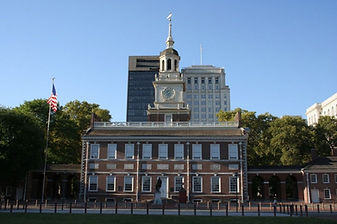

This is where the Declaration rests today - in the National Archives Rotunda. In the photo below, it is on the left side. The Constitution and Bill of Rights are also in there.

Here is a photo of the actual Declaration of Independence. Notice the mysterious hand print in the bottom left.

What is the Boot Monument?
Located in Saratoga National Historical Park in New York is a strange national monument. It's a boot. There is no name on the monument, making it the only war memorial in the United States that does not honor the soldier by name.


This "Boot Monument" is in honor of infamous traitor Benedict Arnold, who fought heroically at the Battles of Saratoga. His leg was wounded in the battle, and a few years later he became a traitor after disagreements with the Continental Congress.
The Battles of Saratoga were the turning point of the Revolutionary War, and caused France to agree to join the war effort on the American side.
Jace's Spectacular NHD Project! Here's the Press Enterprise Story:
INLAND PEOPLE: Student recognized at state History Day competition for Reagan project:
Moreno Valley student interviews late president’s son for History Day project.

For her National History Day website project, Jace Thornley didn’t just cull through books and old magazine articles to learn about the foreign policy aspect of President Ronald Reagan’s time in office.
The 13-year-old Moreno Valley resident took her project on Reagan’s role in ending the Cold War a step further, interviewing one of the late president’s sons, members of his cabinet and a Pulitzer Prize-winning biographer.
Jace, who recently finished eighth grade at Vista Heights Middle School, sent emails to several people she came across during her research and landed interviews with Michael Reagan, the president’s oldest son, as well as former Secretary of State George P. Schulz, and one-time National Security Advisor Robert MacFarlane. She also spoke to Edmund Morris, Reagan’s official biographer, Russian scholar Suzanne Masie, and Ward Churchill, a professor, author, and political activist who provided Jace with the dissenting opinion on Reagan required for her project.
Normally pretty shy, Jace said she decided she had nothing to lose by reaching out to those who knew Reagan well, she said.
“It was kind of nerve wracking because they are so big in history, and I’m just a kid,” she said.
Jace opted to examine Reagan’s “peace through strength” approach to foreign policy because of the ample resources she found at the Ronald Reagan Presidential Foundation and Library Simi Valley. Her website project earned her first place in her category at the district level. She advanced to the county competition, earning second prize. Her showing at the county level advanced her to the state competition in Sacramento, where her project finished fourth and earned her an Honorable Mention.
Aurelio Cortez, Jace’s history teacher, said he was disappointed his student didn’t move on to the national History Day competition because he felt her website was the best in the state. The Moreno Valley Unified School District also honored Jace.
For her project, which was focused on the theme “Leadership and Legacy in History,” Jace compiled 136 sources and interviewed 10 statesmen, experts, historical archivists and politicians.
Cortez said Jace’s effort demonstrates how hardworking she is and how she always strives for excellence.
“She was able to succeed in National History Day because she genuinely loved her topic and has the natural curiosity that all good historians have,” he said. “She put months of work into her project and kept learning until the end.”
The lessons Jace learned while working on her website can be applied to other classes she takes down the line, Cortez said.
“The great thing about History Day, if you love your topic, is that the project never really ends,” he said. “Jace was able to connect with some pretty powerful and significant people, and the information she gleaned from them will help her in history classes in the future.”
Jace’s mother Julie Bostock said the judges were impressed with the extra effort her daughter made on the project. Bostock said she could see a difference in her daughter from the start to when she headed into the state competition.
“I was very impressed with how she improved with at the beginning being uncomfortable in front of people,” Bostock said. “With the state judges, she was very calm. I saw the growth.”
Jace, who will be attending Canyon Springs High School in the fall, said while she enjoyed her project and a recent class trip to Boston, Philadelphia, and Washington, D.C., history is not among her favorite subjects. She prefers math and has already taken geometry. The avid reader and aspiring math teacher enjoys the Percy Jackson series of books and loves photography. She is also learning to play volleyball.
With all of her other pursuits, however, the teen said she wouldn’t rule out competing again in History Day once she delves into high school.
Jace said she enjoyed learning about Reagan’s leadership style and his legacy.
“He showed an excellent example of leadership and he had a legacy that impacted the world,” she said. “I got a great example of the kind of leaders he was, humble and modest, not looking for credit. Just doing what was right.”
The Legend of Hercules Mulligan

Mr. Cortez at the Grave of Hercules Mulligan
We’re all familiar with the legendary heroes who fought to secure our independence from the British: George Washington, Benjamin Franklin, Paul Revere and his midnight ride. But there are many other influencers of the Revolutionary War whose names don’t immediately come to mind when reflecting on the birth of this great nation. Their efforts and contributions are no less significant or important to securing the freedoms we enjoy every day. The heroics of their lives and stories remain unsung, like many of those serving their country in the shadows today.
This Fourth of July, to celebrate the anniversary of our independence, we are shining the spotlight on one such hero, a man who risked his life to save General George Washington. Twice. A man who helped convert Alexander Hamilton from a Tory to a Patriot. A man who successfully ran his own business and used that business to live among the British, befriending them and covertly acquiring information while overtly tarnishing his reputation with the Patriots. That’s right, Hercules Mulligan.

An American Patriot Living Among the British
Hercules was born in Ireland in 1740. He and his family immigrated to New York when he was about 6 years old. In 1774 he opened a clothing emporium catering to the crème de la crème of New York society. He also catered to wealthy British businessmen and high-ranking British military officers. He employed several tailors but preferred to greet his customers himself, taking the customary measurements and building rapport among his clientele. His business thrived, and he established a solid reputation with the gentleman of the upper class and with the British officers. It was his associations within these circles that made it acceptable for him to marry the niece of Admiral Sanders of the Royal Navy.
Hercules harbored no allegiance towards the British despite his wife’s lineage or the demographics of his customers. In fact, he was a member of the Sons of Liberty, a secret society created to protect the rights of the colonists. He was also a member of the New York Committees of Correspondence and Observation, a group opposing the British through written communications. Hercules’s patriot tendencies were established a good ten years before the start of the Revolutionary War.
Hercules and Alexander Hamilton
In 1773 Hercules opened his doors to a young student named Alexander Hamilton who was in New York to complete his studies. The two had been introduced by Hercules’s older brother Hugh. Hamilton took up board with Hercules while attending King’s College (now Columbia University). It was during this time that Hercules, along with several others, had a profound impact on Hamilton.
Originally, Hamilton supported British rule over the colonies. He then began to develop his pro-Patriot views from a variety of sources, among them New Jersey Governor William Livingston (one of the signers of the US Constitution) with whom he lived in New Jersey before attending Kings College.

Hamilton then moved in with Hercules in New York and they had many late night discussions, further influencing Hamilton’s views. Hamilton soon joined the Sons of Liberty and, at age 18, he wrote a persuasive essay defending the case for independence. His letter was one of many essays instrumental in hastening the Revolution, especially in New York.
The Revolutionary War began in April 1775. After Washington was defeated at Long Island, Hercules tried to leave New York. He was stopped the next day by a party of Tory militiamen who captured him and dragged him back to the city. He reluctantly returned and carried on outfitting the British officers.

On July 9, 1776, he led a group of patriots to New York's Bowling Green, a park at the lower end of Broadway. In the center of the oval greensward stood a hated symbol, a huge gilded statue of King George III, perched regally astride a horse. Mulligan and his fellow Sons of Liberty broke through the iron fence surrounding the park and toppled the gleaming British monarch. As cheers rang out, the men hacked the statue apart and paraded the pieces through the streets. Beneath its gold gilt, the statue was made of lead, which colonists melted down and cast into bullets to be used against the British.
A Spy is Made
When General Washington mentioned to Alexander Hamilton, now Washington’s aide-de-camp, that he was looking for a spy on the inside within New York City, Hamilton recommended his old friend Hercules Mulligan. Hercules excitedly agreed.
Hercules continued to provide service for British officers, collecting their measurements and secrets alike. He played to the officer’s vanities, stroking their egos to elicit statements of speculation. When officers requested repairs to their uniforms, he would ask the date they needed them back. When customer after customer gave the same date, he could surmise the day of their next movement. He would then dispatch his African-American slave, Cato, to Washington’s headquarters in New Jersey to share the information on the redeployment of a particular unit.
Saving George Washington
Late one evening an excited and flustered British officer called upon Hercules to provide him with a coat. Hercules complied and inquired about the late hour for such a request. The eager officer all too readily responded that he was departing on a mission to capture General Washington within the day. After hurrying the officer from his store, Hercules immediately dispatched Cato to alert Washington of his impending capture. The British had learned the location where Washington would be meeting with his troops and had planned an ambush. Thanks to the acquisition of this information, General Washington was not captured the following day.

Two years later, Hercules was again afforded the opportunity to save the life of General George Washington. In February 1781, British General Sir Henry Clinton learned of Washington’s plans to travel to Rhode Island via the Connecticut shoreline. He ordered 300 troops onto transport boats to intercept Washington. And who was responsible for loading these boats with provisions for the journey? None other than Hugh, Hercules’s older brother. Hugh promptly advised Hercules of the plan. Hercules dispatched Cato, and Washington immediately rerouted his course and arrived safely in New England.
Hercules and Cato did not survive the war unscathed. Cato was once captured and beaten on a return trip to New York after passing intelligence to Washington’s headquarters. Hercules was suspected by the British on several occasions and even spent time in jail before using his Irish charm to slip away back to his emporium.

Clothier to General Washington
The greatest danger came to the pair following the end of the war in 1783. Hercules had appeared too close with the British officers despite his true intentions, and he feared tarring and feathering or some other act of revenge. Anyone who supported the British was in danger.
General Washington, however, had not forgotten his confidential correspondent. He paid a visit to Hercules’s house after attending an “Evacuation Day” parade in New York. He had breakfast with Hercules and then went shopping in his store, alleviating any doubts as to which side Hercules had been on during the war. After becoming president, Washington continued to update his wardrobe from the Irish tailor. Hercules took advantage of this unique public relations opportunity and changed the sign outside his shop to say: “Clothier to Genl. Washington.”
Hercules’s Legacy
Hercules’s business remained a success for years to come. He and Hamilton became two of the 19 founding members of the New York Manumission Society, an early American organization founded to promote the abolition of slavery. He retired when he was 80 years old and died five years later. Hercules' tomb is in New York’s Trinity Church, next to his friend Alexander Hamilton. Hamilton had been killed by Vice President Aaron Burr. The vice president had challenged Hamilton to a duel. Burr’s shot mortally wounded Hamilton who died the following day.
Hamilton was one of America’s Founding Fathers, he was the first Secretary of the Treasury, appointed by George Washington. He distinguished himself as one of New York City’s most prestigious attorneys, and he convinced New Yorkers to agree to ratify the US Constitution. It was the late night discussions with Hercules Mulligan that set him on this path.
So, this Fourth of July while you gaze upwards as bursts of red, white and blue color explode in the night sky, think about those lesser known heroes, think about the men and women whose small contributions made large impacts on the founding of this great nation. Think of Hercules Mulligan.
Courtesy of: https://www.cia.gov/news-information/featured-story-archive/2016-featured-story-archive/the-legend-of-hercules-mulligan.html and http://www.foxnews.com/opinion/2012/07/04/this-july-4-let-thank-forgotten-revolutionary-war-hero.html
Galco's Soda Pop Shop
Watch my favorite episode of my favorite show:
I've been to Galco's many times, and have even taken Staff members to enjoy their sodas and sandwiches. Since I began telling my students about Galco's, many of them have gone with their families. Here's a photo of Nathaniel with his most recent receipt from there ... he spent $125.00!!
Also a photo of Jake, after chatting with Galco's owner, John Nese.


The Articles of Confederation
This week we began a unit on the Critical Period, the time period after the Revolutionary War from 1781-1789. During this era, America was governed by our first constitution, the Articles of Confederation. It had many problems and the United States had some serious issues.

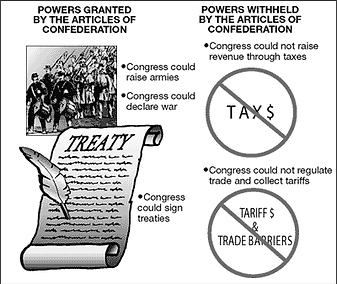


The Constitutional Convention of 1787
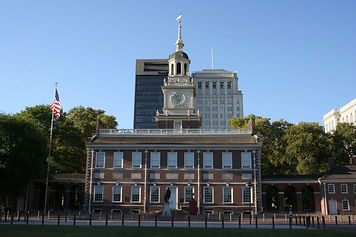
Soon, we will be analyzing the heated debates that took place at the Constitutional Convention in 1787. The 55 delegates at the secret meeting debated many topics, including:
1) How much power should the National Government have?
2) How much power should State Governments have?
3) What rights of the people should be protected by the government?


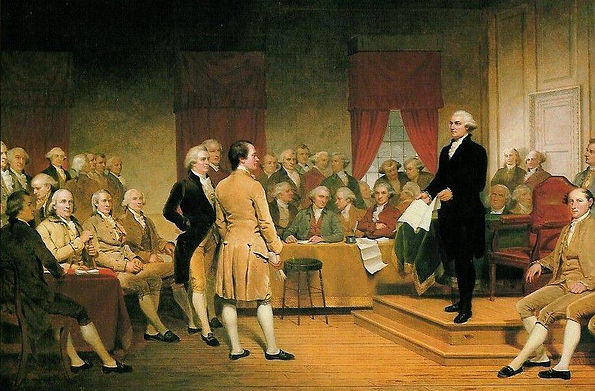

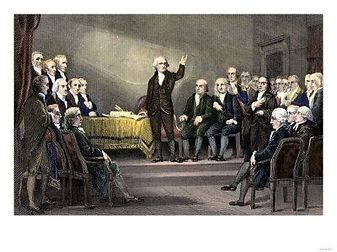

Below is a painting depicting a scene of prayer, following Ben Franklin's speech to all the delegates, reminding them that "God governs in the affairs of men."

Announcements
- All students are required to bring their Chromebooks and planners to class every day.
- I am currently taking signups for the East Coast Tour ... space is limited!
- Interested in Speech Meet? See Mr. Cortez for more info
Follow on Social Media!
Photo Slideshow




CortezHistory Poll
Recent Blog Entries
Upcoming Events
8/14 - First Day of School!
8/20 - Back-to-School Night (virtual)
9/20 - UCR Field Trip, Periods 4 & 6
Lame Jokes
Q. What did the worker at the rubber band factory say when he lost his job?
A. Oh snap!
Q. What's black and white and red all over?
A. A bloody chessboard!
Q. What did the big bucket say to the little bucket?
A. You look a little pail!
Chuck Norris Facts
- Chuck Norris threw a grenade and killed 50 people ... then it exploded.
- Sharks have a week dedicated to Chuck Norris.
- Chuck Norris has a diary: It's called The Guinness Book of World Records.
- Chuck Norris sleeps with a pillow under his gun.
- Once a cobra bit Chuck Norris' leg. After five days of excruciating pain, the cobra died.
- Chuck Norris doesn't call the wrong number... you answer the wrong phone.
- Chuck Norris's email address is Yahoo@ChuckNorris.com
- When Chuck Norris turned 18, his parents moved out.
Websites
Why Study History?
What is History About?
The Philosophy of History
Timelines.com
Old Magazine Articles
#1 Song Today in History
Have Fun With History
Best History Sites
Electoral College Results
Supeme Court Cases in US History
Landmark Cases of the Supreme Court
US History Summary Outline
US History Summaries by Topic
Today in History
9/11 Digital Archive
The White House/President
Constitution Center
Plimoth Plantation
Colonial Williamsburg
Mount Vernon
National History Day
National Archives
Smithsonian Institution
National Portrait Gallery
National Museum of American History
Library of Congress
Black History
Women in World History
Historical Documents
Historical Writing
American Presidency Project
CIA
FBI
Apple Student Tours
Common Core Social Studies Literacy Standards
Vista Heights Website
Recent Photos
Mr. Cortez' Favorite Movies
1) Jailhouse Rock (1957)
2) Rocky III (1982)
3) Superman II (1980)
4) Groundhog Day (1993)
5) Rocky (1976)
6) Back to the Future (1984)
7) Bill & Ted's Excellent Adventure (1989)
8) The Wizard of Oz (1939)
9) Superman I (1978)
10) Rocky IV (1985)
11) Willy Wonka & the Chocolate Factory (1971)
12) Back to the Future II (1989)
13) Big (1988)
Mr. Cortez' Favorite Shows
1) California's Gold with Huell Howser
2) Jeopardy!
3) This Week in Baseball
4) Quantum Leap
5) Saved By The Bell
6) The Twilight Zone
7) The Wonder Years
8) Wings
9) Mystery Science Theater 3000
10) Gilligan's Island
11) Tom & Jerry
12) Growing Pains
13) The Simpsons

The Debates at the Constitutional Convention
Why You Should Take Your Education Seriously
As a kid, there were times when I questioned the importance of getting an education. If that sounds like you, then you need to realize that there are many reasons why taking your education seriously is important. Just watch this girl answer a question in the Miss Teen USA competition a few years back. You will never take your education for granted ever again!
The Greatest Schoolhouse Rock Song
Memorize and sing this song in front of the class for extra credit!
Washington's Rising Sun Chair
At the end of Constitutional Convention - after four months of debate and compromise in creating the US Constitution - Ben Franklin made a comment regarding George Washington's chair. Franklin was waiting to sign the Constitution, when he stared at the chair (seen below) and said:
"I have often looked at that picture behind the president without being able to tell whether it was a rising or setting sun. Now at length I have the happiness to know that it is indeed a rising, not a setting sun."
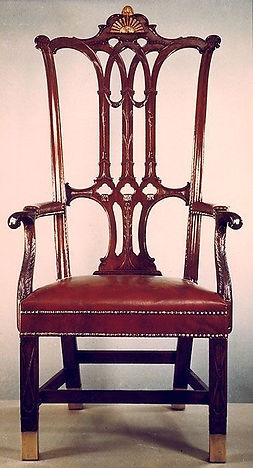


Sam sitting in a REPLICA Rising Sun chair at the Museum of the American Revolution, Philadelphia
Soccer Fans Are At It Again!
Just when I think soccer fans couldn't get any more sleazy, they decide to show up in wheelchairs to get better seating! Read about it here:

Softball During Second Lunch Begins Soon...
Why Are We A Republic?
Often, people in our country will say that America is a democracy. This is an error that would make our Founding Fathers furious! We are a Republic, according to Article 4, Section 4 of the Constitution. Our Founders made it very clear what they thought about democracies, as you will see below in the quotes. After you read, watch the video.
Democracies have ever been spectacles of turbulence and contention; have ever been found incompatible with personal security, or the rights of property; and have, in general, been as short in their lives as they have been violent in their deaths. - James Madison
Remember, democracy never lasts long. It soon wastes, exhausts, and murders itself. There never was a democracy yet that did not commit suicide. - John Adams
A democracy is a volcano which conceals the fiery materials of its own destruction. These will produce an eruption and carry desolation in their way. The known propensity of a democracy is to licentiousness [excessive license] which the ambitious call, and ignorant believe to be liberty. - Fisher Ames, Author of the House Language for the First Amendment
We have seen the tumult of democracy terminate . . . as [it has] everywhere terminated, in despotism. . . . Democracy! savage and wild. Thou who wouldst bring down the virtuous and wise to thy level of folly and guilt. - Gouverneur Morris, Signer and Penman of the Constitution
[T]he experience of all former ages had shown that of all human governments, democracy was the most unstable, fluctuating and short-lived. - John Quincy Adams
A simple democracy . . . is one of the greatest of evils. - Benjamin Rush, Signer of the Declaration
In democracy . . . there are commonly tumults and disorders. . . . Therefore a pure democracy is generally a very bad government. It is often the most tyrannical government on earth. - Noah Webster
Pure democracy cannot subsist long nor be carried far into the departments of state, it is very subject to caprice and the madness of popular rage. - John Witherspoon, Signer of the Declaration of Independence
It may generally be remarked that the more a government resembles a pure democracy the more they abound with disorder and confusion. - Zephaniah Swift, Author of America's First Legal Text
Jefferson's Five Purposes of Government
In his inaugural address in 1801, Thomas Jefferson laid out what he believed were the five purposes of government. Click here to read his Inaugural Address.
The Lewis and Clark Expedition
I have always believed that the expedition of Lewis and Clark was by far the most exciting and dangerous journey in American history, even more that the flight to the moon. Watch this video to learn about this amazing adventure:
The War of 1812 - American's Forgotten War
Andrew Jackson in a Nutshell


We just finished studying Andrew Jackson's administration and I would like to summarize the key concepts that all students should take away from his career as a general and President:
I. The Battle of New Orleans:

Jackson gained national fame as the victorious general in the final battle of the War of 1812, the Battle of New Orleans (an unnecessary battle, since the Treaty of Ghent was signed a couple weeks beforehand... oops!). He absolutely crushed the British in the battle.
II. Jackson Gets Florida:
In 1818, Jackson was sent into Florida, then owned by Spain, to maintain the peace, since some Native Americans were ravaging Georgia plantations. Jackson went further than he was commanded. He killed some foreign rulers and captured others, demonstrating to Spain that Florida was not able to be protected by them. As a result, Spain and the US signed the Adams-Onis Treaty, giving Florida to the US (among other things that it did).
III. The Presidential Election of 1824 was a four-way one: Andrew Jackson [West] vs. J.Q. Adams [NE] vs. Henry Clay [Old Northwest] vs. William Crawford [South]. The result was that, while Andrew Jackson led in both electoral and popular votes, he was unable to obtain a majority (more than half). Thus, the election was then thrown into the House of Representatives, where each state would cast one vote to select the President. Clay was dropped, as he was in last place, Crawford had a stroke?so it was down to Jackson and Adams. It was close, but all of a sudden, Clay [Speaker of the House] decided to back Adams. Jackson supporters called Adams? victory the ?Corrupt Bargain? b/c soon after the election Clay was chosen Secretary of State in Adams? administration and his American System was supported. So, with that slight issue, the DR party split into the?
- National Republicans [J.Q.A. supporters] ? the NRs generally favored a more involved gov?t that had an active role in numerous aspects of peoples? lives.
- Democrats [Jackson supporters] ? the Democrats had a wide range of views, but basically they stuck to the Jefferson concept of an agrarian society w/limited gov?t intervention and feared the concentration of economic and political power. They stressed the importance of individual freedom and were against reform b/c it required a more activist gov?t.
Anyhow, during his administration J.Q. proposed a strong nat?list policy [Clay?s American System] that included protective tariffs, a nat?l bank, and internal improvements. J.Q. believed that the gov?t should play an active role in the economy, education, science, and the arts.
- However, J.Q.A. stunk as a politician, and the Democrats made it all worse by sabotaging him at each opportunity. So basically he got nothing done. And then came the Election of 1828.
III. Jackson wins the Election of 1828:


- Jackson, now nicknamed "Old Hickory," gets his revenge in the Election of 1828, with the help of his supporters. He wins easily, beating J.Q. Adams. This election was the slimiest, sleeziest, nastiest, dirtiest campaign in all American history. Jackson's wife, Rachel, was attacked so badly that she died right before the election!
IV. The Spoils System:

-Jackson began a practice that was called the Spoils System, where he fired government employees and replaced them with his Democratic supporters.
V. Jackson vs. South Carolina: The Nullification Crisis
- The main issue of Jackson's first term was the Nullification Crisis, which is a little bit complicated at first, but turns out to be a hugely important moment in US history... it is a mini-preview of coming attractions: The Civil War! Here's what happened in the Nullification Crisis:
- The whole nullification thing started in 1828 when the Tariff of Abominations (nicknamed by the South) passed. A tariff is a tax on imported goods from another country. Remember, Southerners hate tariffs because they help Northern factory owners, while hurting Southern plantation owners who do lots of their trading other countries.
- South Carolina, basing itself on ideas expressed in the 1798 Kentucky and Virginia Resolutions, began protesting the tariff and declaring their right to nullify (cancel) it. Calhoun, the VP, wrote and left unsigned the South Carolina Exposition and Protest [special state conventions can nullify nat?l laws].
- But in the Senate it was Robert Hayne [SC] who argued in favor of states? rights vs. Daniel Webster [MA] in the 1830 Webster-Hayne Debates [?Liberty and Union, now and forever, one and inseparable? ? DW].
- Even though Jackson was a states? rights person, he believed the ultimate authority rested with the people, not with the states. With Calhoun obviously on the state sovereignty side, Jackson turned away from him and began to rely more on Secretary of State Martin Van Buren.
- So in 1832 Congress tried to make the problem go away by reducing some of the duties but keeping them on iron, cottons and woolens. This was not good enough for South Carolina, who not only disliked the duties themselves but also feared that they could set a precedent for legislation on slavery.
- In November 1832, then, a South Carolina state convention nullified both tariffs and made it illegal to collect them w/in state boundaries. In response, Jackson passed the Force Act, which gave the president authority to call up troops and to collect duties before ships reached the state, while at the same time recommending tariff reductions to give SC a chance to back down.
- Calhoun, who had resigned as VP and become a South Carolina Senator, decided to work w/Henry Clay and eventually came up w/ the compromise Tariff of 1833, which reduced duties over a 9 year period. SC was satisfied and repealed its nullification law [but nullified the Force Act, which Jackson ignored].
- Although the crisis was over, neither side really had won a decisive victory... although Jackson had shown that the laws of this nation must be followed (just like Lincoln, thirty years later).
VI. Jackson kills the National Bank:

- First of all, in the Presidential Election of 1832, the main issue was the early removal of the Second Bank of the United States? charter, which was due to expire in 1836. Jackson was all for the bank?s removal, attacking it as a center of special privilege and economic power; Henry Clay wanted to recharter it.
- In reality, the Second Bank of the US held federal funds and was an important source of credit for businesses. It also kept state banks honest by not accepting notes w/o gold to back them ? so state banks weren?t exactly the nat?l banks biggest fans [saw it as private institution unresponsive to local needs].
- Anyhow, Jackson was reelected easily [random note: this election first in nation?s history where candidates chosen by conventions] and quickly proceeded to take down the bank in 1833. Here?s what he did?
- Basically, Jackson began by taking the $ in the nat?l bank and putting it in state-chartered banks ? thereby shrinking the bank and making it just another private bank after 1836.
- Then came the Deposit Act of 1836, which allowed the Secretary of the Treasury to choose one bank per state to do what the SBUS used to. The act also provided that any federal surplus over $5 million be given to the states starting in 1837. The surplus [from speculation in public lands] was then put into bank notes by state banks. This worried Jackson, who hated paper $, so?
- He convinced Secretary of the Treasury Levi Woodbury to issue the Specie Circular, which said that after August 1836 only gold/silver could be used to pay for land. This reduced sales of public land and killed the surplus and the loans to the states.
- This policy was a total disaster. This economy stuff is confusing, but the idea is that even though there were fewer land sales and less land, people continued to speculate. The increased demand pressured banks, which didn?t have enough specie, and credit contracted ? fewer notes issued, fewer loans made.
- Jackson just made things worse by continuing his hard $ policies, and his opponents had a field day. Congress then voted to repeal the circular, but Jackson pocket-vetoed this and the policy stood until in mid 1838 a joint resolution of Congress killed it.
- Jackson was the first President to really use his veto powers, which was another reason why he was attacked as being ?King Andrew.?
VII. Jackson vs. Native Americans:

- As Americans increasingly pushed West, the former occupants inevitably were forced onwards as well. Although the Constitution acknowledged Indian sovereignty and gov?t relations w/Indian leaders followed internat?l protocol, in reality, it was a bunch of garbage.
- Basically, the US used treaty making to acquire Indian land ? through either military or economic pressure the Indians were forced to sign new treaties giving up more and more land. Some Indian resistance continued after the War of 1812, but it only delayed, not prevented, the US.
- Many Indian nations attempt to integrate themselves in the market economy. For example, some lower Mississippi tribes became cotton suppliers and traders. This turned out badly, though, b/c the trading posts would extend debt to chiefs that would later be used to force them off the land.
- As the cotton economy spread, then, Indians fell into patterns of dependency w/the Americans, which made it easier to move them. Indian populations also fell drastically due to war and disease.
- The US gov?t also attempt to assimilate the Indians into American culture [in 1819 $ was appropriated for that cause and mission schools were est.] Missions taught the value of private property and Christianity. For most, however, assimilation seemed too slow, and illegal settlers began crowding Indians everywhere.
- By the 1820s it was obvious the Indians just weren?t about to give up land fast enough, and attention turned to the more powerful, well-organized southeastern tribes.
- In 1824, prompted by pressure from Georgia, Monroe suggested that all Indians be moved beyond the Mississippi River [no force would be necessary, he thought]. This was aimed primarily at the southern Creeks, Choctaws, Chickasaws and Cherokees, who all rejected the proposal.
- In the end, all the tribes were moved, making it clear that even adapting to American ways could not prevent removal. The Cherokees were the best example ? they had a written language created by Sequoya, schools, churches... even a constitution and political structure, but the South refused to respect them. They appealed to the SC in Cherokee Nation v. Georgia (1831) and the court ruled in their favor. Still, Georgia refused to comply.
- Jackson decided not to interfere b/c it was a state matter [really b/c he just wanted to kick out the Indians anyway] and allowed the Indians to be forced out w/funds from the Removal Act of 1830. The Choctaws were moved first, then the Creeks.
- Finally the Cherokees [who were divided ? some wanted to give up and exchange their land for western land, most didn?t want to give up] were marched by military escort in the Trail of Tears in 1838 after their lobby to the Senate failed.
- Removal was a disaster for the Indians [you think?] ? many became dependent on the gov?t for survival, internal conflicts arose, as did problems with existing tribes.
- In Florida a small band of Seminoles continued their resistance through a small minority under Osceola that opposed the 1832 Treaty of Payne?s Landing, which provided for their relocation. When troops were sent in 1835, Osceola used guerilla warfare against them until his capture and death in prison, after which the group fought under other leaders until the US gave up in 1842.
The Nastiest Election in US History - 1828
My View of Andrew Jackson
Jackson is one of the most divisive figures in history... people tend to either love him or hate him. Sometimes people ask me my opinion of him, so I thought I would share it here. Basically, while I think Jackson did a few good things and had a few good policies, overall I think Jackson is a terrible president. He ignored the Supreme Court three times, facilitated an economic depression, and was a brute. I share the same view as Thomas Jefferson, who said:
"I feel much alarmed at the prospect of seeing General Jackson President. He is one of the most unfit men I know of for such a place. He has had very little respect for laws and constitutions, and is, in fact, an able military chief. His passions are terrible. When I was President of the Senate, he was Senator; and he could never speak on account of the rashness of his feelings. I have seen him attempt it repeatedly, and as often choke with rage. His passions are, no doubt, cooler now; he has been much tried since I knew him, but he is a dangerous man."
Watch the following video for a very thorough explanation of Jackson:
The Trail of Tears as told by Johnny Cash


Maddison Places 2nd in the Nation!!
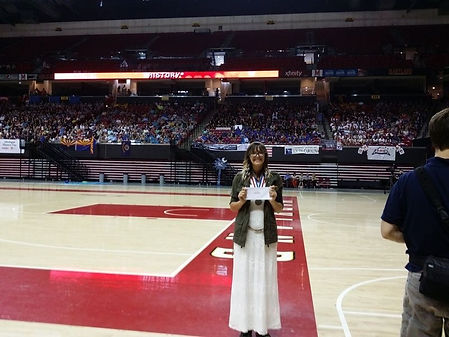

Here's the article from the Press Enterprise:
Moreno Valley Canyon Springs incoming freshman Maddison Zipper spent countless hours and many late nights in order reach the 2014 Kenneth E. Behring National History Day Contest at the University of Maryland June 15-19.
?Lots of late nights, adding things to the board, polishing it, making it look nice,? said Zipper about her project for the contest.
Zipper bested nearly 3,000 students from across the country to capture second place in the Junior Individual Exhibit Category.
?My goal was to get first, I was expecting to place top three based on the other exhibits, and the amount of work I put in,? Zipper said.
Zipper?s exhibit, titled ?Rights Affirmed, Responsibilities Articulated in Tinker vs. Des Moines,? tackled the court case which revolved around students who were suspended for wearing black armbands in protest of the Vietnam War.
?From day one, it was her plan to not just take it (National History day), but she was going to win,? said Jo Ann Gillespie, Moreno Valley Unified School District History Day Program facilitator.
Students were tasked with this year?s theme ?Rights and Responsibilities in History? and completed projects focused on citizens' rights.
?The summer of my seventh grade year I went to Washington D.C. on a leadership conference. At the museum there was a display on First Amendment rights and that?s what inspired me to create this exhibit,? said Zipper.
The projects ranged in five categories: exhibits, performances, papers, documentaries, and website and were judged.
?You set up your board for the exhibit, the directors walk through to look at it, and there's an interview stage with the judges,? said Zipper on how her project was graded.
Two other students from Riverside County schools were honored with ?Outstanding in State? awards: Martin Luther King High school student Rachel Priebe in the Senior Individual Documentary Category and Frank Augustus Miller Middle School student Haley Hocking in the Junior Individual Documentary Category. Seven Riverside County students reached the National History Day competition.
?The experience was once in a lifetime and I think everyone should compete in History Day at least once ? it?s an amazing opportunity,? said Zipper.
Before finishing in second place at the national level, Zipper shared the History Day state title with fellow Vista Heights Middle School eighth grader Samuel Hornaday; both were named Junior Division co-champions in the Individual Exhibit category.
?Maddison is a uniquely gifted and driven student; no one who knows her is surprised by this tremendous accomplishment. Her project was extensively researched and her arguments were clearly presented,? said History Day advisor Aurelio Cortez, who added that Zipper created the highest-placing History Day exhibit in the history of the Moreno Valley Unified School District.
The Riverside Convention Center hosted the National History Day state competition April 24-27, featuring 1,000 students from 20 counties. For Zipper, she jumped at the opportunity.
?I've always kind of liked history, American history, U.S. history is very fascinating to me,? said Zipper, who plans to take a year off from the competition.
?It does take a lot of time and my teachers were very understanding of History Day,? Zipper said.
Next year?s theme for History Day is ?Leadership and Legacy.?
Writer: Pep Fernandez
Congrats to Sam, too, for being the CA State History Day co-champion (with Maddison) and making it to Nationals! He created an incredible exhibit and I learned a lot from him and his research:

Soccer Player Reaches a New Low!
I've seen soccer players and fans do some of the most despicable acts I've ever seen in athletics... but this may be the worst!!
A stray dog learned the hard way during a soccer match in Argentina that you apparently don't interrupt lower-league player Enzo Jose Jimenez
.
And what exactly, did the Bella Vista plater do about the match interruption? He picked up the dog by its neck and hurled it off the field, right into a fence!!
Watch the sad video below:
Another ridiculous soccer incident ... this time involving explosives!!
Video footage showing players milling around a field during a club soccer match in Isfahan, Iran, captures several objects on the ground. Some of them appear to be trash or plastic bags. One of these objects though turns out to be an explosive.
The footage posted on YouTube shows a player picking up what is being described as a live ?grenade? (although it doesn?t seem it is a grenade in the traditional sense of the word), seemingly not recognizing what it was, and throwing it casually off the field seconds before it went off.
The Number One Reason I Hate Soccer
As you know, I hate soccer and think it is the world's worst sport. I believe it is racist, violent, and boring. But the number one reason I hate it is because of the fakers it produces. Watch the video below to see some of the world's WORST actors!
The Assassination of President Garfield
The second president in US History to be assassinated was James Garfield. But he didn't have to die... watch to find out the details behind his death:
Black Heroes in American History
It's sad, but a significant portion of African-American history is largely forgotten or simply ignored. For some reason, dozens of black heroes in American History are not even mentioned in our school textbooks. Watch the videos below to learn things you've probably never learned before!
More Black Heroes in Early American History!
A while back, I posted some videos about black heroes in American History (scroll down to view those). Some of my students were excited about the topic, since most of our textbooks leave out this kind of information. So I decided I would post some more videos for your education and enjoyment.
Some Random East Coast Trip Photos
To view hundreds of East Coast Tour photos, click on "ECT Photos" above. Videos can be found on my YouTube channel: youtube.com/user/cortezhistory/videos.
Here's an OLD video of some of my students having the "Time of their life," eating lunch in Plymouth, Massachusetts, overlooking Cape Cod Bay...
Here are some random East Coast Trip pictures from past years:




